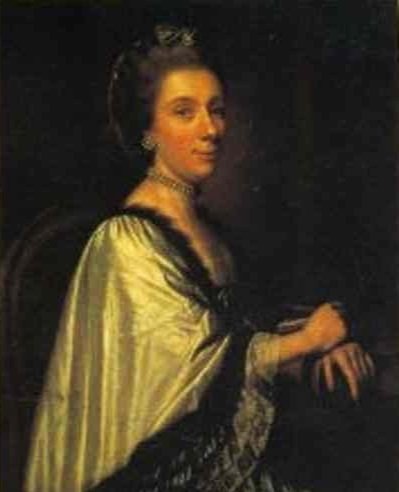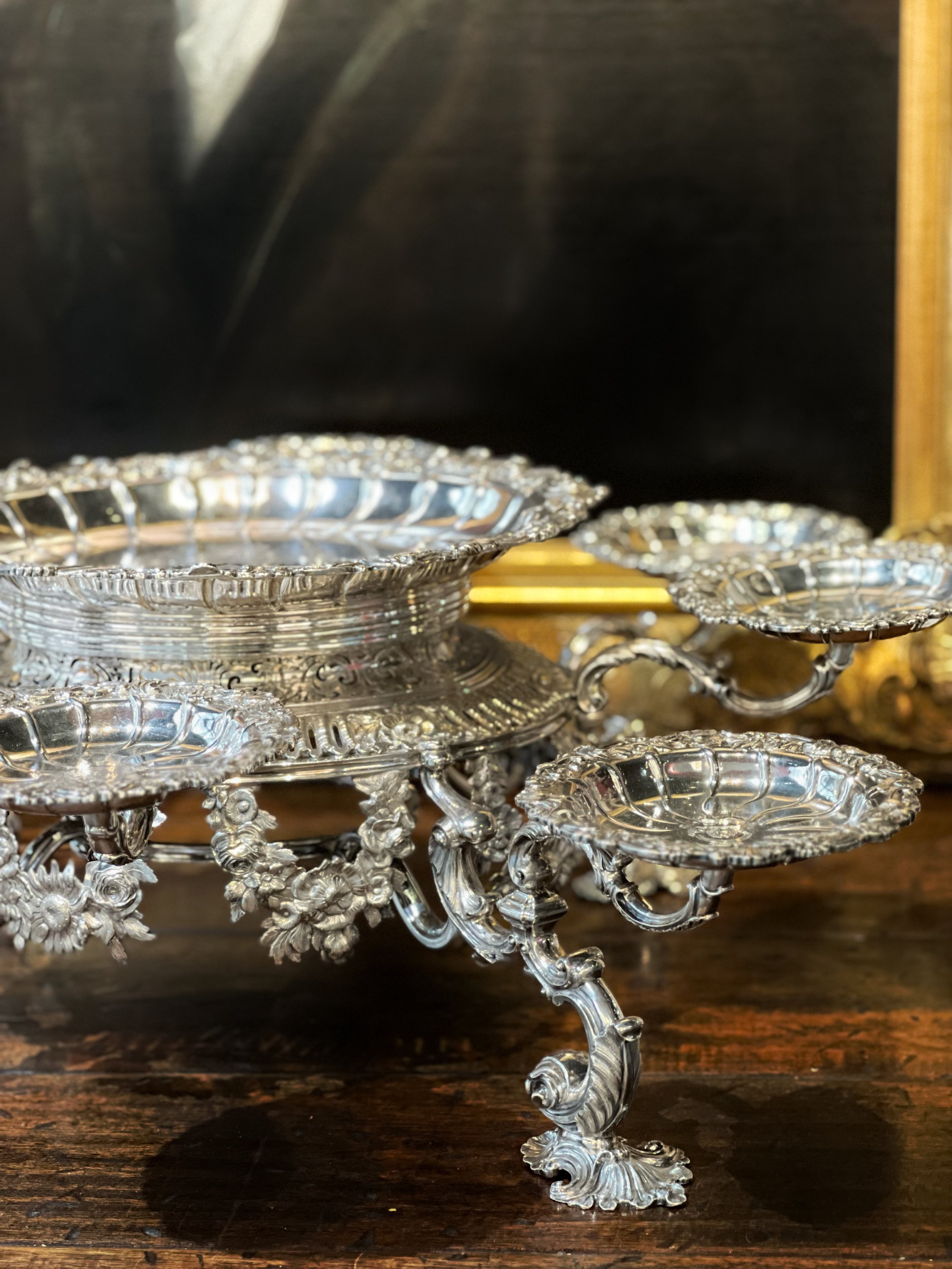Forgotten Girl Bosses of 18th Century London
English silversmith Louisa Courtauld (1729–1807) headed her firm. Her clothes and jewelry suggest her wealth and success. She is elegantly attired in a silk green cape trimmed with fur. Her jewelry is set in silver to reflect her industry. Photo from Wikipedia.
When we think of what girls could do with their lives back in the 18th century, marriage and babies tops the list. The period dramas we stream lead us to believe that a woman’s employment options at that time were limited to governess, domestic servant or religious life.
As a heavy consumer of those shows, it came as a big surprise to me when I learned that women in the 1700s owned and managed their own firms. Their work was generally concentrated in the trades that produced luxury products related to fashion, design and decorative arts. They produced furniture, fans, millinery, silver and gold objects and even, in the case of one extraordinary pioneer, statuary and architectural elements used by top architects such as Robert Adam and John Nash. Among them, these women employed thousands of men and women. Ironically, the female-led businesses were based in the heart of today’s male-dominated financial district, London’s Square Mile (aka, the “City”). It seems the glass ceiling in the City was shattered centuries ago.
Epergne, 1753 by Elizabeth Godfrey. Photo by Lynn Byrne.
I discovered this phenomenon when I went to see a fine piece of silver called an epergne at antique silver and jewelry dealer S. J. Shrubsole on Madison Avenue. An epergne is like a lazy susan. It is a centerpiece with removable baskets that hold a variety of foodstuffs. This one, ornately decorated in the rococo style, was once owned by the 2nd Earl of Hopetoun.
An epergne, like this one by Elizabeth Godfrey, is like a lazy susan holding a variety of foodstuffs in the center of a table. Photo by Lynn Byrne.
Ben Miller, the director of research at Shrubsole, told me that the epergne was produced by a woman, Elizabeth Godfrey. He explained that Elizabeth was the daughter of a silversmith and married two men in the trade. She ran her own firm after her first husband died and then went into business with her second husband, who is believed to have been her employee. After he died in 1741, Elizabeth ran the firm alone for two more decades. The epergne was produced during her solo management in 1753. Ben pointed out that the epergne itself shows that she had a lot of employees because its fabrication required many different skills —engraving, pierce work, casting, soldering, etc. Today her work is prized among collectors of 18th century silver.
Elizabeth follows one common model for the 18th century businesswoman. She went into the family trade. Recent analysis of a collection of business cards, wills, livery licenses and other ephemera held by the British Museum shows that this was considered normal back then. Elizabeth had obviously taken an active role in the silver business prior to first becoming a widow. She knew what to do. She registered her own mark a mere five weeks after husband number one died.
Elizabeth Godfrey’s trade card, akin to a modern business card. Photo via Wikipedia from the British Museum.
Ben mentioned two other prominent female silversmiths from the period, Hester Bateman and Louisa Courtauld. Hester knew an opportunity when she saw one. Records show that she could not write (she made her signature with a mark), but this didn’t prevent her from starting a gold and silver firm one year after her husband’s death in 1760 using her bequest as seed money. Hester did not take over his existing business. Although his will shows that he left her his tools, he was a gold chain maker and wire cutter. She began a new, albeit related, venture.
As the century progressed, entrepreneurial Hester capitalized on new technologies. Around 1774, Hester’s firm became one of the first silversmiths to produce wares using Sheffield plate. The thin gauged sheet silver was a much less costly material than solid silver and used machines to punch and pierce it. By adopting it, Hester greatly expanded her market with more affordable product. After heading her business for almost thirty years, Hester Bateman retired in 1790. Her company was run by a succession of relatives until it finally closed in 1843.
Mary Cassat’s painting Five O’clock Tea shows a tea service very similar to one made by the Bateman firm after Hester’s death in the collection of the Museum of Fine Arts, Boston. Photo via Wikipedia.
Silver by Hester Bateman, 1780s. Photo via Wikipedia.
Louisa Courtauld, whose portrait is seen in the first image, produced silver for nobles much like Elizabeth Godfrey. The existence of Louisa’s portrait itself shows that Louisa had wealth. She is wearing fine clothing and the artist was possibly Johann Zoffany, a societal portraitist who also painted members of the Royal Family. This suggests that working in a trade was not reserved for women in the lower classes of society.
A British 18th century fan in the collection of the Metropolitan Museum of Art.
Being married back then did not mean a woman had to give up her career. In the Sleepe family, three sisters, Martha, Mary and Esther, followed their mother’s example and went into the fan making business. Martha, didn’t marry. Mary and Esther both continued to work after they wed husbands who had entirely different careers. Mary’s husband John Sansom was a handle maker and wood turner, as their joint business card shows. Esther Sleepe probably made more money than her husband Charles Burney. He was a muscian who hob knobbed with composers like Joseph Haydn but his profession did not garner a high wage. Esther also bore Charles 6 children, several of whom grew up to be highly accomplished. Fanny Burney, her daughter, wrote 4 novels, 8 plays, one biography and many journals and letters. She is described as a precusor to Jane Austen. Her son Charles was a noted classicist and another son, James, became an explorer who accompanied Captain James Cook on his last voyages. Talk about having it all. Esther not only supported the family, she raised children remembered by history.
Mary Sleepe Sansom and her husband John’s trade card in the collection of the British Museum.
Esther Sleepe via Semantic Scholar.
One powerful woman, Eleanor Coade, was a total self starter. She never married and founded a business completely unrelated to her family’s work in textiles. Although first employed as a linen draper, Eleanor left that trade. Around 1769, after her father went bankrupt for the second time and then died, she bought an artificial stone factory that she managed for over fifty years until her death. She did not invent artificial stone but she is credited for perfecting the clay recipe and firing process. Eleanor’s factory produced neoclassical statues, architectural decorations and garden ornaments made from a molded ceramic stoneware product then called Lithodipyra but now commonly referred to as Coade Stone after her. Josiah Wedgwood produced a similar product by complained that he could not gain a foothold in the market. Historians suggest his failure occurred because his contemporary Eleanor Coade produced a superior product. Coade Stone is extremely durable and is seen today throughout Britain, including at St. George’s Chapel at Windsor, The Royal Pavilion at Brighton, and Buckingham Palace.
The facade of Elizabeth Coade’s home, Belmont, featuring architectural embellishments in Coade Stone.
No one knows why women stopped participating in management and commerce at the end of the 18th century. Like a unicorn, women in power vanished. It has been a slow climb back.
The Unicorn Gate in Coade Stone in Kew Gardens, London. Photo via Wikipedia.












